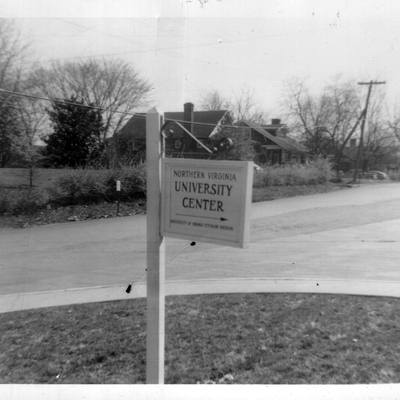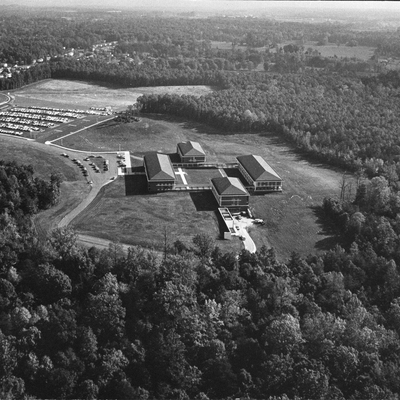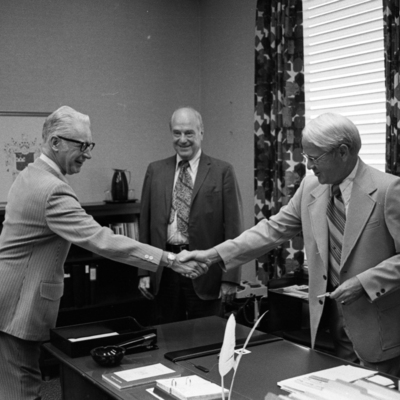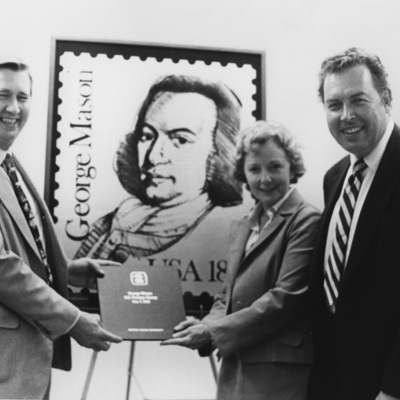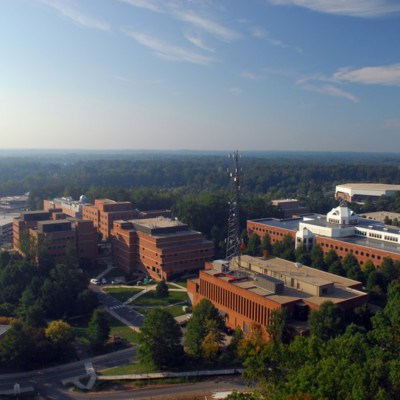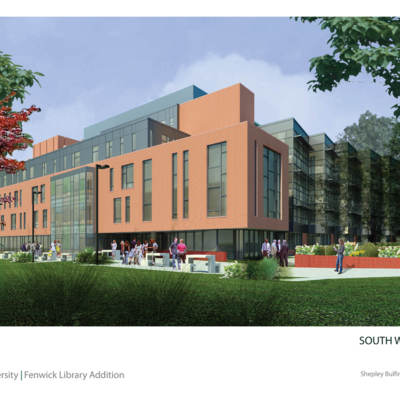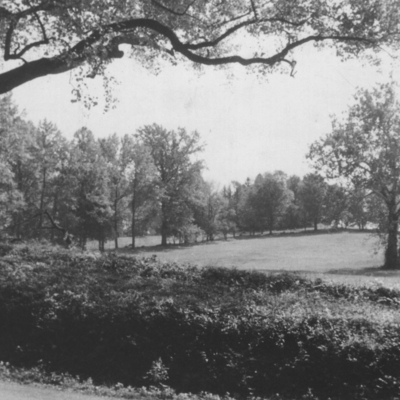Learning Outside of the Box: PAGE, The Honors College, and New Century College
During the 1980s and 1990s, George Mason University aimed to improve on the quality of its academic offerings and provide students with an education in multiple fields. University President George W. Johnson, beginning with the PAGE program in 1981 and continuing with New Century College in the early 1990s, envisioned programs that would provide students with a solid, interdisciplinary approach to education with the objective of better preparing them for working in the real world.
In September of 1981, Dr. Johnson met with faculty members to discuss the possibility of creating a program that would bridge the divide between “general education and the contemporary world.”[1] One year later, a committee was established whose members were tasked with designing a new general education program for freshmen and sophomore students. [2] This program would retool Mason’s general education courses to give each class a more interdisciplinary approach. It had been suggested that this approach helped students develop more marketable and relevant technical and communication skills. Thus, the Plan for Alternative General Education (PAGE) program was born. The two-year general education sequence would consist of “strands” of courses that would span over four semesters; “strand seminars” would seek to connect the seemingly unrelated courses. [3] The general education classes covered topics including mathematics, natural sciences, biology, computer technology, and non-Western cultures. There would be no GPA requirement to enter the program, although a student must be accepted by the program at the beginning of their freshman year to participate. The Commonwealth of Virginia provided $500,000 towards the program’s “curriculum development and faculty training.”[4] Faculty members from several departments across campus were eager to help in creating and teaching the new PAGE curriculum. The Robinson Professors in particular were major advocates of the PAGE Program, with Drs. James Trefil and Robert Hazen playing instrumental roles in the creation of Scientific Thought and Processes I and II (PAGE 227 and 228), the program’s science sequence. [5] In 1983, the PAGE Program, based in the Finley Building, opened the doors to its first class of students.
George Mason University physics professor William Lankford served as the director of the PAGE Program during its first year. English Professor Patrick Story was its final director beginning in 1990. [6] In 1993, the program had begun to require a minimum GPA for admission, and although it meant tougher admission standards for the program, administrators were quick to insist that nothing else in the program was changing. In 1997, the Faculty Senate voted to convert the PAGE Program into an honors program. In 1998, the last PAGE Program class graduated from the general education sequence. The new Honors Program moved from the Finley Building to a new student lounge and office in Student Union I.
Professor Story remained with the Honors Program and served as its first director. In 2009, the Honors Program was revamped and expanded to become the Honors College. [7] This new college at Mason would include not only the former Honors Program, but also the University Scholars Program, the Undergraduate Apprenticeship Program, and the Postgraduate Fellowships and Scholarships Program. Honors Program Director Dr. Zofia Burr was promoted to Dean of the Honors College, and her colleague Dr. Kathleen Alligood was promoted to the position of Associate Dean. By 2009, the Honors Program had expanded many of its offerings in the science and math fields, bolstering its Science, Technology, Engineering, Economics, and Mathematics (STEM) track. Many of today’s Honors courses, such as Conceptions of Self (HNRS 130), Reading the Arts (HNRS 122), and Scientific Thought and Processes II (HNRT 228), have been carried over from the original PAGE Program.
The Zero-Based Curriculum or ZBC, the original working title for Mason's New Century College, was developed as a project of University Librarian Charlene Hurt. First discussed in 1993, the project was to be a partnership between the University Libraries and the Department of Public & International Affairs, creating an entirely redesigned undergraduate curriculum. As a collateral benefit the Libraries' computing capabilities would be upgraded. "Zero-Based” meant that this new curriculum would not be hampered by already “existing general education or degree requirements.”[8] The new academic structure would use small classes and integrate information from multiple disciplines and perspectives. The team in charge of implementing ZBC hoped it would spread learning outside the classroom and take advantage of the new technologies being built. $200,000 was allocated through a statewide program for the technology necessary for the program and an additional $300,000 was earmarked to design the curriculum. [9]
In late 1993, concerns were raised about the ZBC by faculty and administrators. Some wondered whether faculty members would be willing to devote their time to teaching new courses designed for ZBC. It was expected that the majority of students entering the program would be coming from traditional academic backgrounds at Mason, thus the issue of how easily existing students could integrate into the program was raised. As for students who may be transferring out of Mason, it was asked how well ZBC would prepare students for programs at other universities. Lastly, administrators were concerned that too many choices were available to ZBC students, exposing the need to bolster academic advising.
The ZBC Program’s initial implementation began in the spring of 1994 when the pilot run of a new Design Exhibition course (CS 490) was approved by the University. [10] The goal of this course was to allow students to work together in groups to create a software program. The ways in which students interacted together, and the learning that transcended the walls of the classroom, were to be the foundations of the ZBC Program.
The program finally was fully implemented into Mason's academic curriculum and named the New Century College for the 1995-1996 academic year, after being approved by the University's Board of Visitors in November 1994. [11] This new program, through which students could earn a Bachelors of Arts or Science in Integrative Studies, was divided into three divisions. The first division consisted of a core curriculum which was to be completed during a student’s first academic year. The core curriculum consisted of four courses, including one course which would assist in the freshman college transition and provide students with the necessary skills for future college courses. [12] The other core curriculum classes focused on the natural world, the social world, and students as citizens. The second division introduced students to “learning communities,” which were created to facilitate better relationships between students and faculty. In addition, this division would ease time constraints for commuting students. The last division consisted of specialized courses based on a student’s area of interest. All students in New Century College were also expected to partake in learning through experience, such as engaging in a practicum or internship. English faculty member, Dr. John S. O’Connor, was selected as the first Dean of New Century College. In January 2004, New Century College was integrated into the College of Arts and Sciences, known today as the College of Humanities and Social Sciences. [13]
The PAGE program and New Century College are examples of unique academic endeavors pursued by George Mason University in an attempt to offer alternatives to traditional undergraduate education. New Century College today is one of the largest programs of its type at Mason. The PAGE program, which was reborn as today's Honors College, is seen as one of the most prominent honors programs in the country. As George Mason University continues to thrive and grow, these two iconic programs continue to develop along with it.
Browse items related to PAGE.
Browse items related to New Century College.

